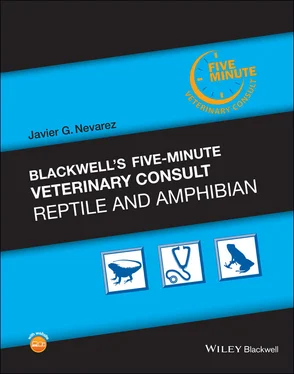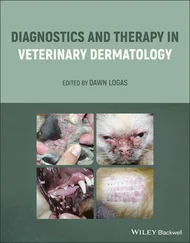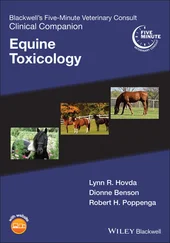Purulent dermatitis
Subcutaneous abscesses
Superficial pyoderma
AST = aspartate aminotransferase
CPK = creatine phosphokinase
PCR = polymerase chain reaction
UVB = ultraviolet B
Kaplan M. Treating Abscesses in Reptiles. Melissa Kaplan’s Herp Care Collection. 1996, last updated January 1, 2014. www.anapsid.org/abscess.html
Negron V. 4 Diseases Your Pet Reptile Can Give You. May 1, 2015. www.petmd.com/reptile/care/diseases‐your‐pet‐reptile‐can‐give‐you
PetMD Editorial. Internal Abscesses in Reptiles. July 28, 2008. www.petmd.com/reptile/conditions/skin/c_rp_internal_abscesses
1 Huchzermeyer FW, Cooper JE. Fibriscess, not abscess, resulting from a localized inflammatory response to infection in reptiles and birds. Vet Record 2000; 147:515–517.
2 Mayer J, Pizzirani S, DeSena R. Bilateral exophtalmos in an adult iguana (Iguana iguana) caused by an orbital abscess. J Herp Med Surg 2010; 20:5–10.
3 Williams SR, Sims M, Roth‐Jonson L, Wickes B. Surgical removal of an abscess associated with Fusarium solani from a Kemp’s ridley sea turtle (Lepidochelys kempii). J Zoo Wildl Med 2012; 43:402–406.
AuthorAlbert Martínez‐Silvestre, DVM, MSc, PhD, DECZM (Herpetology), EBVS European Veterinary Specialist in Herpetological Medicine and Surgery, Acred. AVEPA (Exotic Animals)
Adenovirus
 BASICS
BASICS
DEFINITION/OVERVIEW
Adenoviruses have been found to infect all classes of bony vertebrates and most appear to have co‐evolved with their hosts.
Adenoviral infections in reptiles have ranged from clinically inapparent to enteritis, necrotizing hepatitis, esophagitis, splenitis, and encephalopathy.
Adenoviruses are double stranded non‐enveloped DNA viruses.
They fall in the family Adenoviridae, which is further classified into five currently accepted genera:Mastadenovirus isolated from mammalsAviadenovirus in birdsAtadenovirus isolated from squamatesSiadenovirus found in some chelonians, amphibians and birdsIchtadenovirus isolated from a sturgeon
A sixth genus, Testadenovirus, isolated from tortoises, has been proposed.
AdV infections have been identified in wild‐caught and captive lizards, snakes, chelonians, and crocodiles.
Disease is often a combination of other disease agents and/or stress and the viral infection.
The listing below is of the species reported with an adenovirus isolate.Chelonians: Sulawesi tortoises, red‐footed tortoise, pancake tortoise, Eastern box turtle, ornate box turtle, red eared slider.
With molecular diagnostics, more affected species are expected to be identified.
There is no sex predilection.
Juvenile and/or stressed animals are more frequently reported with disease.
Non‐specific; often the animal is found dead.
Sulawesi tortoises had severe systemic disease and high mortality rate; however, these animals suffered multiple stressors.
Clinical signs included anorexia, lethargy, oral cavity ulcerations, nasal and ocular discharge, and diarrhea.
Subclinical disease has been reported in other tortoises.
Adenoviruses are very stable in the environment and commonly spread through fecal–oral transmission.
Poor biosecurity can help disseminate the virus throughout a collection.
Stressors such as capture, substandard housing, nutritional inadequacies or underlying disease play a role in the development of clinical infection.
Concurrent disease and/or immunosuppression increases the likelihood of severe systemic disease.
Sulawesi tortoises had concurrent amoebiasis, nematodiasis, and/or bacterial sepsis.
 DIAGNOSIS
DIAGNOSIS
DIFFERENTIAL DIAGNOSIS
Intranuclear coccidiosis, mycoplasmosis, and tortoise herpesvirus 1.
PCR may be diagnostic if the test is specific for the adenovirus commonly isolated from the reptile species.
Necropsy and histopathology: appropriate tissues need to be evaluated and, in some cases, additional tests such as TEM and/or PCR molecular diagnostics need to be performed.
Sulawesi tortoises:
Gross lesions: hepatosplenomegaly, thick fibrinonecrotic membranes in the lumen of the large intestine, segmental darkening of the serosal surfaces of the small and large intestine, oronasal fìstulas, and tongue and oral mucosa ulceration.
Histology: heterophilic and lymphoplasmacytic infiltration of intestinal enteritis and hepatic necrosis. The inclusions are basophilic or amphophilic.
 TREATMENT
TREATMENT
APPROPRIATE HEALTH CARE
N/A
Nutritional support should be provided as needed only when the reptile is well hydrated and at an ideal environmental temperature for the species.
An esophagostomy tube should be considered for long‐term care.
CLIENT EDUCATION/HUSBANDRY RECOMMENDATIONS
Quarantine: the current recommendation is for approximately 6 months isolation period for most reptiles, with PCR testing at various intervals.
Post‐outbreak: after diagnosis of an adenovirus infection in a collection, cages and hard surfaces should be thoroughly cleaned with a detergent, followed by disinfection with a 10% bleach solution. A minimum of 10‐minute contact time with the bleach is recommended. All bleached supplies and cages should be thoroughly rinsed afterward and dried. Bleach can be corrosive and can cause respiratory irritation in enclosed spaces.
Direct unfiltered sunlight or other intense ultraviolet sources may also aid disinfection. Proper contact time must be followed if using other disinfectants.
All reptiles should be kept at appropriate temperature and humidity and offered food consistent with their dietary requirements.
 MEDICATIONS
MEDICATIONS
DRUG(S) OF CHOICE
N/A
N/A
 FOLLOW UP
FOLLOW UP
PATIENT MONITORING
Reptiles showing clinical signs should be isolated and provided supportive care.
Any co‐infections should be treated, if possible.
Monitoring weight, appetite, and fecal production will help assess response to therapy and progression of infection.
Utensils and cage furniture should not be transferred from room to room or animal to animal.
Читать дальше

 BASICS
BASICS DIAGNOSIS
DIAGNOSIS TREATMENT
TREATMENT MEDICATIONS
MEDICATIONS FOLLOW UP
FOLLOW UP










